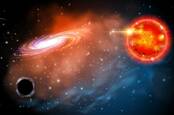This article is more than 1 year old
The mysterious giant blobs of gas around our galaxy's black hole are actually massive merger stars being shredded
Yum, long noodle-like stars
Astronomers have finally figured out what the peculiar object known as “G2” orbiting the supermassive black hole at the center of the Milky Way is: a behemoth star created from the merger of two binary stars being stretched by the extreme tidal forces around the black hole.
The peculiar object has baffled scientists for years. The mystery deepened after a team of researchers led by the University of California, Los Angeles (UCLA) uncovered other bodies behaving in a similar way to G2 elsewhere. They had stumbled across a new class of objects, but weren’t quite sure what those things were exactly.
“They are strange because they appear as gas and dust blobs, but then they behave like stars, making us believe that there is actually a star hidden inside,” Anna Ciurlo, lead author of the study published in Nature on Wednesday and a postdoctoral scholar at UCLA, told The Register. “The question is: how do you get all this material around a star? That’s what led us to put them all in a new class.”
If G2 was just a giant cloud of gas and dust, it would have been ripped apart by the black hole, which would release copious amounts of electromagnetic radiation. But the object continues to persist despite living in such a harsh environment.
“G2 survived and continued happily on its orbit; a simple gas cloud would not have done that,” said Andrea Ghez, co-author of the paper and a professor of physics and astronomy at UCLA. “G2 was basically unaffected by the black hole. There were no fireworks.”
Instead, G2 is actually the result of two massive binary stars merging together to produce one giant star shrouded by gas and dust. The researchers believe that the strong gravitational effects of the supermassive black hole forces stars to smash into one another to create objects like G2. The new star then expands for more than a million years before being swallowed.
“This may be happening more than we thought. The stars at the center of the galaxy are massive and mostly binaries. It’s possible that many of the stars we’ve been watching and not understanding may be the end product of mergers that are calm now,” said Ghez.

Astroboffins rethink black hole theory after spotting tiny example with its own star buddy
READ MOREG2 currently appears to be stretching from “spaghettification,” a process describing the stretching and compression of objects into long thin spagetti-like shape. It occurs when things get too close to a black hole and come under the effects of extreme tidal forces.
“We believe these [objects like G2] are merged binary systems. This process creates a lot of gas and dust around the newly formed star. This material makes these objects large. Therefore, when they pass close enough to the black hole this material can interact with the gravity of the black hole and become stretched, and in some cases pulled away,” Ciurlo explained to El Reg.
The team carried out their research at the W.M. Keck Observatory in Hawaii, home to the world’s two largest optical and infrared telescopes.
“We are starting to understand the physics of black holes in a way that has never been possible before,” Ghez concluded. ®
